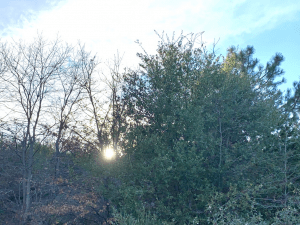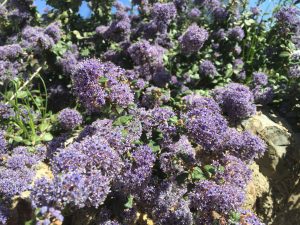Pleasant. So far anyway. If anyone were to describe the winter season 2019/2020 as “pleasant”, I believe I would agree. Here’s a recent poem for cold weather time…
MAUL OAK
_____________
The last log of my fire
This morning
Was canyon live oak
or maul oak,
Quercus chrysolepis.
Frederik Michael Liebmann
A Danish botanist, born 1813
Came to the New World and
Gave the tree its botanical name
Sometime towards the end of his short life of 43 years.
George Bishop Sudworth
An American botanist/dendrologist born 1864
Lived 63 years and surveyed the forest trees of the Pacific slope.
He wrote in 1908
That maul oak could attain an age of at least 250 to 300 years.
So, the actual specimens of a once unnamed tree
Beheld by Liebmann and later studied by name by Sudworth
Might still be casting shade over lilies, orchids, western azalea, and dogwood,
On some cold canyon north face mountain slope out there.
But a big one we know of today has certainly been cut and split into logs for my fire.

The slowest burning, most elegant, best oak firewood I ever lit.
My wood came from an immense tree,
Predating us all by centuries.
In our time it survived a huge fire, and a few more before that one I imagine.
Yet ultimately exposed, laid bare, and with so much destruction all ‘round
It fell under the weight of a heavy snowfall, untimely.
We sawed the green wood and made table size sections of the main trunk,
Visible today in a nursery, with native plants on display for sale.
Branches of firewood size were cut and piled to the side where,
In the forest the logs cured for over a year.
Now, more than 15 years later, they are as solid as rock.
One hundred thousand evenings and mornings make around 275 years.
On this very morning my fifty-year-branch-log made around 5 hours of heat in my home.
Liebmann and Sudworth are long gone and the old tree is sprouting from the base.
To this day I place ashes from my fireplace all ‘round the drip line of trees I have planted
In the belief that this simple gesture might cure disease and promote longevity.
_______________
ME 1/19/20
We have nearly 8 good inches of rain in the gauge so far, and at this time last year the amount was 14 inches. We totaled just shy of 24 inches last year, and of course we have a few months remaining in the current rainy season. Rain is still in the forecast for later this month, and hopefully by summer, we will look back on what was a pleasant and easy winter.
Watering
Established natural gardens require no irrigation at this time, as our rains have been generous and properly spaced for good soak into the ground. That said, after a particularly dry, windy period, your plants might appreciate a refreshing sprinkler to rinse their leaves and remind them what rain is like. Whenever you’re not sure about the need to water, dig a few inspection holes 3-4 inches deep. If the soil is dry, especially now in winter, it’s time to water.
Related to Watering
Between soaking rainfall events, monitor the weather reports. If you think the garden needs water but rain is in the short term forecast, it’s better to wait for the rain. If it doesn’t pan out, or turns out to be too light to soak in, you can always water at that point. Rainwater is always better than hose water.
Establishing
Since fall/winter/spring are the best times to plant natives. Likely you have a few new plants in your garden, or maybe a whole new garden. Always when getting new plants started, you have to pay special attention to the roots in the nursery root ball. While maintaining consistent moisture in the surrounding native soil, be sure to watch the moisture levels in the planting hole, as the nursery root ball tends to dry out quicker than the soil all around. The best way to water new plants is with a soft rain nozzle on a garden hose, which delivers about 5 gallons per minute. Spend 2-4 minutes on each plant if you can, filling the basin and soaking the soil to the bottom of the root ball.
Pruning

Now is a great time to prune a few of those soft branched sub-shrubs you weren’t sure about last fall. Buckwheat, sunflower, sage, Baccharis, California fuchsia, anything you think could use a revival experience can be pruned (no geometric shapes, please) lightly or more severely depending on the situation. With spring weather right around the corner, the plants will start growing back right away. Do not prune ceanothus as they are forming their flowers right now. Shrubby manzanitas only need occasional thinning which is done in the fall. All other woody shrubs should have been artfully pruned, only as necessary, last fall.
Weeding
Yes. With rainfall and pleasant weather come weeds of all sorts. Pulling them is best because you get the root. If the weed crop is very new and the plants are tiny, you can smother them with a fresh application of high-quality top dress. Cutting with a hoe is OK but you will disturb the soil crust which can promote more weed germination. For controlling weeds, proper timing is everything.
Mulching/Top dress
Useful for weed control, see above. If organic top dress is part of your garden narrative, your goal is to maintain a sustainable stand of natives so natural leaf drop is your only mulch. If you have a new garden and you want to cover some bare earth, February through April is an OK time to apply new mulch. Remember, avoid organic material that contains all of these shapes: sticks, strings, flakes, and dust, as it mats up and harms gardens in the long run. Look for top dress material of gritty chunks as found in 1/4 to 1/2 inch bark. 2-3 inches thick is plenty
If your garden calls for a mineral top dress, DG, stone aggregates, pebbles, etc., February is a great time to apply it. Usually 1/2 inch thick is plenty.
With all top dress, do not mound it up around the collar of the plant (where the stem meets the root system).
Feeding
It might be tempting to give your garden a boost with a little organic fertilizer, but the soils are still cold. It will not hurt to feed now, but you may be just encouraging healthier weeds. You can get all your weeds under control, tend your new little wildflower seedlings, have a handle on the top dress and wait until March/April to apply fertilizer which will fortify your plants going into pre-summer.
Troubleshooting – Varmints, Pests, and Diseases
Gophers love this weather and this season. We struggle when we see those telltale mounds of loose soil and an occasional iris or columbine being tugged into the ground. Pray the raptors have greater success and/or set traps. Gophers cannot be tolerated, at least not in great numbers and for me, even one is more than I need.
Bunnies are a bummer but at least their damage is usually only seasonal and on top.
Insects that are considered injurious plant pests can be found all year, the hardiest winter varieties being scale and scale-like mealybug. In the case of a light infestation, wipe the leaves and branches clean with a soft cloth moistened with water and a few drops of an organic dish soap. For heavier infestations, use an insecticidal soap or horticultural oil. Avoid toxins as they will kill beneficials as well.
Snails and slugs can be controlled with bait. Also tell your neighbors to plant natives, stop watering so much, so you can eliminate snails from the whole neighborhood.
 Annual Wildflowers
Annual Wildflowers
We’re down to the wire. If you sowed seed back in November/December, you have a nice crop of seedlings now, unless the bunnies and the snails or slugs got them, in which case see above. They should start blooming very soon. If you have not yet planted wildflower seeds this year, it is almost too late, but by sowing today, you will still get germination, growth, and flowers this season. But don’t put this off any longer. We have great seed mixes ready for every natural garden style.
Adding New Plants
Yes. Every garden is never truly “finished” in as much as every gardener wants to stay involved. Now is a great time to plant new plants. If you do it just before a rain, everybody is happy.
Engage
Isn’t Groundhogs Day (February 2, 2020) halfway between winter solstice and spring equinox? What’s a groundhog anyway? Do coyotes chase them or is that just roadrunners? Are they related to honey badgers? Do they care? Honey badger don’t care. Groundhog don’t care.
All this to say, we’re fast leaving winter behind and marching towards spring. Get out there into them thar hills, mountains, and deserts to catch a last glimpse of our pleasant winter. You’ll see living water in the creeks, colorful dormant twigs, meadows at rest, long shadows, dramatic sunrises and amazing sunsets. Orion commands the night sky and his hunting dogs are out playing with Pleiades.
Bring your inspiration home to make quiet winter designs in your own garden. Anticipate spring the way the hills, greening as we speak do. And keep these experiences close at hand, as our cold season memories will be hard to even imagine as true, six months from now when we’re out absorbing the long hot days of summer.
From the Garden,
Mike Evans
Questions? Help is just one call or one email away. Call (949) 728-0685 or email (with pictures if you like) our special helpline: gardenhelp@californianativeplants.com
To get our monthly updates, sign up for our eNewsletter at this link here.